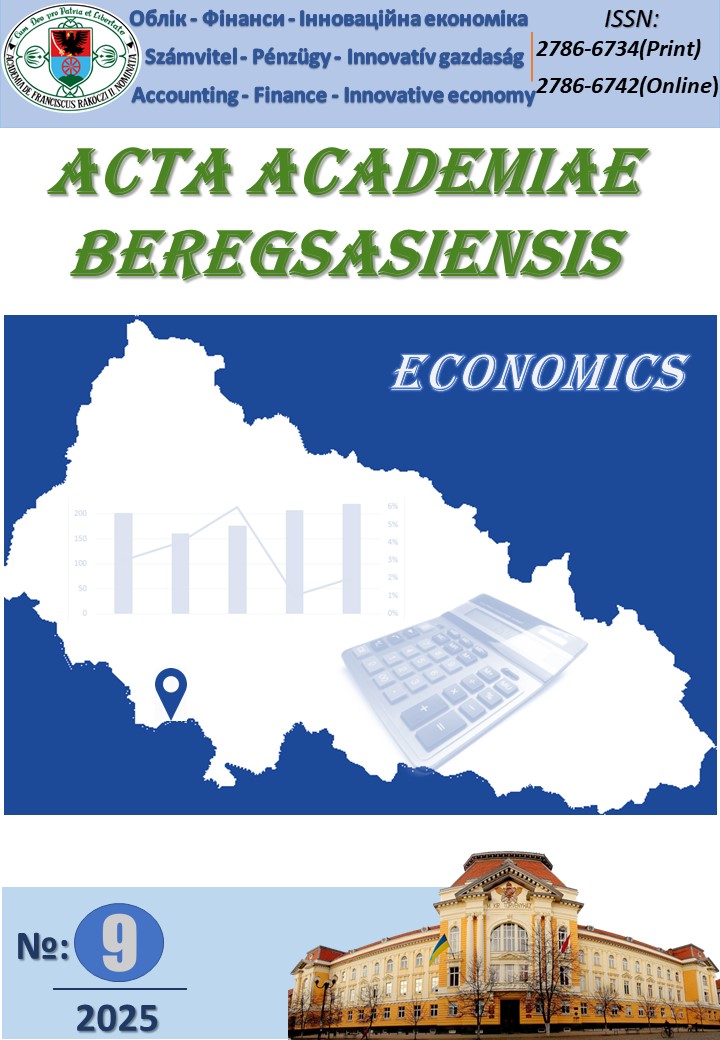The Role of Electronic Customs Systems in Ensuring Transparency and Efficiency of Cross-Border Trade Operations
DOI:
https://doi.org/10.58423/2786-6742/2025-9-284-296Keywords:
customs efficiency, customs modernization, digital transformation, electronic customs systems, international trade, trade openness, trade policy, Ukraine, virtual assets, functional aspect, investmentsAbstract
On the background of unstable worldwide trade and rising significance of digital technologies in public administration, customs procedures modernization gains a strategic importance for many economies. As a geographically relevant crossroads of Western and Eastern markets, adoption of electronic customs systems for Ukraine is essential for realization of openness, efficiency and transparency in cross border trade operations. This article looks into the influence of the electronic customs system implementation for Ukraine in respect to the trade openness and customs efficiency during the time period of 2020-2024. The objective of the study is to assess the degree to which the digital customs transformation adds to the improvement of the country's trade performance in eliminating bureaucratic barriers and enhancing faster and reliable customs processes. Methodology of this research is used to quantify the direct and indirect effects of electronic customs penetration on the most important trade related outcomes: a simultaneous equations model is designed and several dynamic panel estimation techniques are employed in order to improve treatment of unobserved heterogeneity and to estimate with more precision the effects of interest. The model consists of macroeconomic controls (GDP growth rate, exchange rate volatility, inflation and FDI inflows) and structural variables (digital infrastructure, institutional readiness and government policy incentives). The results indicate statistically significant positive relationship of an increase in the proportion of electronically processed customs declarations on trade openness while reducing customs clearance times. Also, digital readiness of infrastructure and quality of policy implementation are proven to be vital mediating variables which contribute to the effect of electronic customs systems. The empirical results are compared with the previous international research and show that Ukraine’s digital customs reforms are state-of-the art in comparison with the global best practices and theoretical expectations. These results are explained in frameworks of institutional and transaction cost economics in order to explain how digital tools can reduce inefficiency, increase compliance, and increase operational transparency. The statistical tests relevant to endogeneity and model specification are shown to provide support for the robustness of the findings. Finally, this article shows that the adoption of the electronic customs systems has greatly increased openness and efficiency in Ukraine’s cross border trade during the studied period. These findings stress the need to keep investing in customs digitalization, institution capacity building, and international cooperation. Further research prospects include the examination of regional differences in the adoption of the system, the embedding of new technologies such as blockchain and the economic effects of the digital customs reforms.
References
Chang, Y., Iakovou, E., & Shi, W. (2020). Blockchain in global supply chains and cross-border trade: A critical synthesis of the state-of-the-art, challenges and opportunities. International Journal of Production Research, 58(7), 2082–2099. https://doi.org/10.1080/00207543.2019.1651946 DOI: https://doi.org/10.1080/00207543.2019.1651946
Surucu-Balci, E., Iris, Ç., & Balci, G. (2024). Digital information in maritime supply chains with blockchain and cloud platforms: Supply chain capabilities, barriers, and research opportunities. Technological Forecasting and Social Change, 198, 122978. https://doi.org/10.1016/j.techfore.2023.122978 DOI: https://doi.org/10.1016/j.techfore.2023.122978
Bajwa, N., Prewett, K., & Shavers, C. L. (2020). Is your supply chain ready to embrace blockchain? Journal of Corporate Accounting & Finance, 31(2), 54–64. https://doi.org/10.1002/jcaf.22423 DOI: https://doi.org/10.1002/jcaf.22423
Truby, J., Dahdal, A., & Caudevilla, O. (2022). Global blockchain-based trade finance solutions: Analysis of governance models and impact on local laws in six jurisdictions. Global Journal of Comparative Law, 11(2), 167–196. http://dx.doi.org/10.2139/ssrn.4371699 DOI: https://doi.org/10.1163/2211906X-11020001
Harris, C. G. (2022). Towards a blockchain solution for customs duty-related fraud. In S. Sakr & A. Zomaya (Eds.), Database Systems for Advanced Applications: DASFAA 2022 International Workshops (pp. 120–134). Springer. 10.1007/978-3-031-11217-1_9 DOI: https://doi.org/10.1007/978-3-031-11217-1_9
Shope, M. L. (2022). Distributed ledger technology in international trade: Rethinking the role and necessity of the customs declaration. Stanford Journal of Blockchain Law & Policy. https://stanford-jblp.pubpub.org/pub/dlt-in-international-trade-customs (Accessed May 10, 2024) DOI: https://doi.org/10.30875/9789287071002c003
Prokopenko, O., Koldovskiy, A., Khalilova, M., Orazbayeva, A., & Machado, J. (2024). Development of Blockchain Technology in Financial Accounting. Computation, 12(12), 250. https://doi.org/10.3390/computation12120250 DOI: https://doi.org/10.3390/computation12120250
Koldovskiy, A. (2024). Strategic infrastructure transformation: Revolutionizing financial sector management for enhanced success. Acta Academiae Beregsasiensis. Economics, 5(2024), 323–332. https://doi.org/10.58423/2786-6742/2024-5-323-332 DOI: https://doi.org/10.58423/2786-6742/2024-5-323-332
Tyagi, N. K., & Goyal, M. (2023). Blockchain-based smart contract for issuance of country of origin certificate for Indian customs exports clearance. Concurrency and Computation: Practice and Experience, 35(16), e6249. https://doi.org/10.1002/cpe.6249 DOI: https://doi.org/10.1002/cpe.6249
National Bank of Ukraine. (2024). Statistical data and analytical reports. https://bank.gov.ua/
OECD/WTO. (2023). Aid for Trade at a Glance 2023: Empowering Connected, Sustainable Trade. Organisation for Economic Co-operation and Development and World Trade Organization. https://www.oecd.org/trade/aft/
State Customs Service of Ukraine. (2024). Annual customs activity reports and statistical data. https://customs.gov.ua/
State Statistics Service of Ukraine. (2024). Official statistical data. https://ukrstat.gov.ua/
International Trade Centre. (2024). Trade Map: Trade statistics for international business development. https://www.trademap.org/
World Bank. (2024). World Development Indicators. The World Bank Group. https://databank.worldbank.org/source/world-development-indicators
Downloads
Published
Issue
Section
License
Copyright (c) 2025 Oksana Okhrimenko, Olena Volkova

This work is licensed under a Creative Commons Attribution-NonCommercial 4.0 International License.
Authors retain copyright and grant the journal right of first publication with the work simultaneously licensed under a Creative Commons CC BY-NC License.


